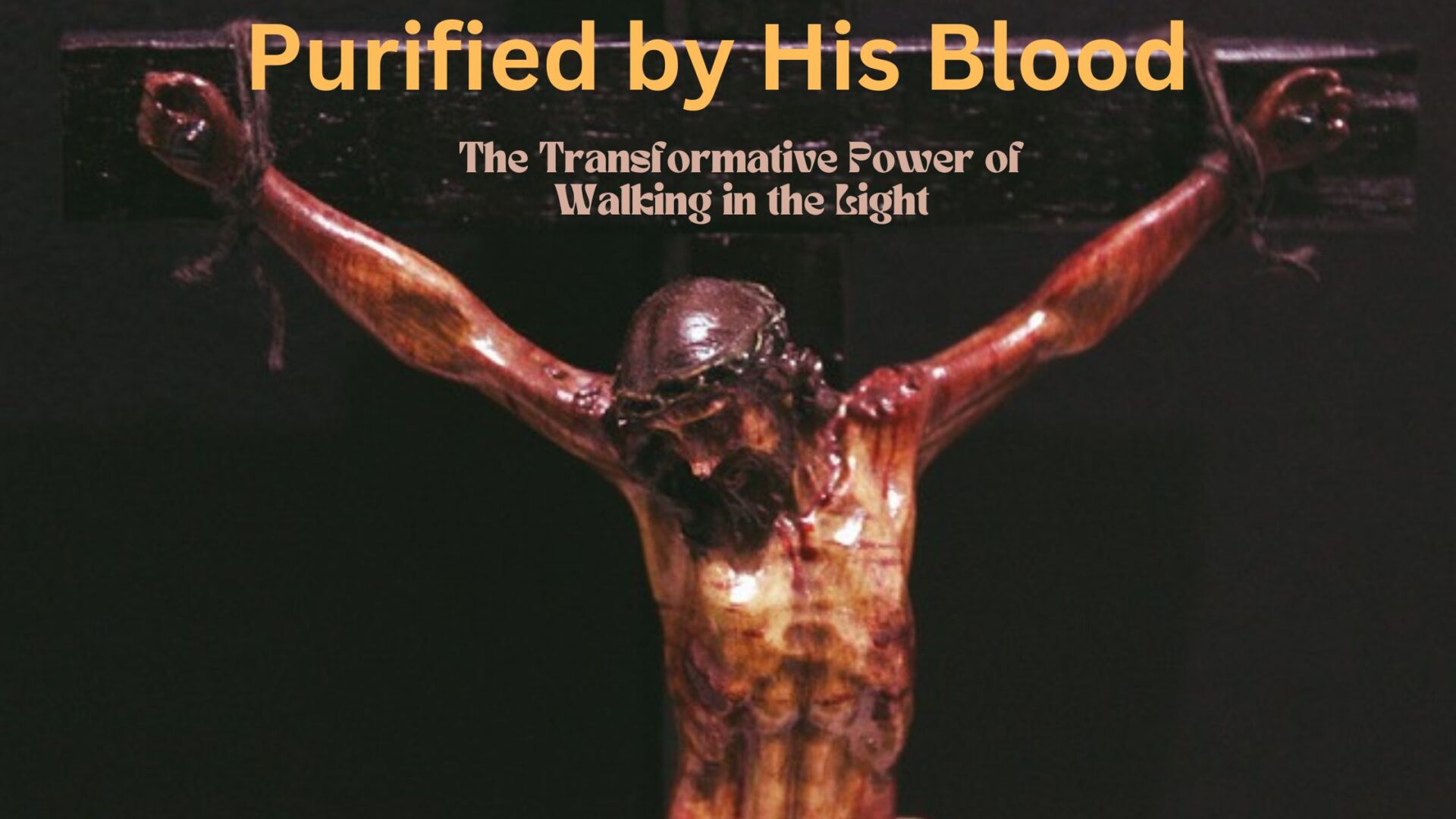Introduction:
Purified by His Blood: The Transformative Power of Walking in the Light

Amidst the daily grind, we may overlook the profound spiritual truths that shape our faith. One such truth is revealed in 1 John 1:7. This verse highlights the significance of “walking in the light,” which symbolizes communion with God and the transformative power of Jesus’s blood in cleansing us from sin. Let’s explore the concept of walking in the light, its implications, and how it relates to spiritual growth and purification.
Exploring the Meaning of Walking in the Light
Embracing the concept of walking in the light entails aligning one’s life with God’s divine truth and righteousness. It involves actively embodying the teachings of Jesus in daily actions. This idea is reinforced in Ephesians 5:8, where Paul exhorts believers to transform from darkness to light and to live as children of light. Walking in the light requires rejecting sinful behaviors and adopting a lifestyle that reflects God’s holiness and boundless love.
Fostering Fellowship Through the Light
One significant aspect of walking in the light is the fellowship it cultivates among believers. When individuals walk in the light, they naturally connect with others who share similar values and faith. This communal bond is highlighted in Hebrews 10:24-25, which encourages believers to spur one another toward love and good works, while also not neglecting regular gatherings and mutual encouragement. As the Day approaches, the importance of this fellowship grows even more profound.
Why is Jesus’ sacrifice referred to as purified by His blood?
In Christian theology, Jesus’ sacrifice on the cross is understood as the ultimate atonement for humanity’s sins, referred to as purification by His blood. Here are some key reasons and biblical foundations for this concept:

1. Atonement in the Old Testament:
In the Old Testament, the concept of atonement is closely associated with the sacrificial system. Animal sacrifices were offered to atone for the sins of the people, with their blood symbolizing life and forgiveness. Leviticus 17:11 emphasizes the significance of blood in making atonement for one’s life.
2. Jesus as the Perfect Sacrifice:
The New Testament presents Jesus as the perfect and ultimate sacrifice, fulfilling and surpassing the Old Testament sacrificial system. Unlike repeated animal sacrifices, Jesus’ sacrifice is a one-time event, as Hebrews 9:12-14 explains. It is through His blood that believers can obtain eternal redemption and purification from sin.
3. Purification from Sin:
Jesus’ blood is seen as purifying because it cleanses believers from their sins, making them righteous before God. 1 John 1:7 highlights this cleansing power, emphasizing that walking in the light and embracing Jesus’ blood purifies believers from all sin. This purification is a continuous process as believers seek forgiveness and strive to live in accordance with God’s will.
4. Symbol of the New Covenant:
Jesus’ sacrifice also signifies the establishment of a new covenant between God and humanity. During the Last Supper, Jesus spoke of this new covenant, emphasizing that His blood is poured out for the forgiveness of sins (Matthew 26:28). This covenant is based on grace and faith rather than adherence to the old laws and rituals.
5. Redemption and Reconciliation:
The shedding of Jesus’ blood is seen as the means by which humanity is redeemed from the bondage of sin and reconciled with God. Ephesians 1:7 underscores this redemption, emphasizing that through Jesus’ blood, believers receive forgiveness of sins and enter a right relationship with God. This transformative power of Jesus’ sacrifice enables believers to live transformed lives.
The reference to Jesus’ sacrifice as purification by His blood is deeply rooted in biblical theology. It signifies the fulfillment of Old Testament sacrificial practices, emphasizes the cleansing power of Jesus’ death, and highlights the establishment of a new covenant that brings redemption and reconciliation with God. This profound act of love and grace underlines the transformative nature of Jesus’ sacrifice, which is central to Christian faith.
How does walking in the light transform a person’s life?
Walking in the light, as described in 1 John 1:7, refers to living in accordance with God’s truth and righteousness. This spiritual practice brings about profound and tangible transformations in a person’s life.

1. Enhanced Fellowship and Unity:
Walking in the light fosters deeper and more meaningful relationships with other believers. When individuals share a commitment to living in the light, they experience greater unity, support, and a sense of community. This is exemplified in the early Christian communities described in Acts 2:42-47.
2. Moral and Ethical Clarity:
Living in the light brings a heightened sense of moral and ethical clarity. The light of Christ illuminates right from wrong, guiding believers to make choices aligned with God’s will. Ephesians 5:8-9 emphasizes the transformation from darkness to light and the call to live as children of light.
3. Inner Peace and Contentment:
Walking in the light leads to inner peace and joy, stemming from a clear conscience and a close relationship with God. Psalm 16:11 speaks of the path of life that brings joy in God’s presence and eternal pleasures. This peace transcends circumstances, offering stability and contentment.
4. Ongoing Spiritual Growth:
The commitment to walking in the light leads to ongoing spiritual growth and personal holiness. Believers strive to reflect Christ’s character, growing in virtues such as love, patience, kindness, and self-control. 2 Peter 1:5-8 encourages believers to add to their faith goodness, knowledge, and other virtues.
5. Empowerment to Resist Temptation:
Living in the light equips believers with the strength and resolve to resist temptation. With the Holy Spirit’s guidance and the support of a faith community, individuals can overcome sinful habits and patterns. 1 Corinthians 10:13 assures believers that God provides a way out of temptations and helps them endure.
6. Clear Purpose and Direction:
Walking in the light gives believers a clear sense of purpose and direction, grounded in God’s will and plan for their lives. Proverbs 3:5-6 advises trusting in the Lord and submitting to His ways, resulting in a straight path.
7. Positive Influence on Others:
Believers who walk in the light become beacons of hope and inspiration to others. Their lives serve as testimonies of God’s love and transformative power. Jesus encourages this in Matthew 5:14-16, calling believers to let their light shine before others, leading to glorification of God.
8. Ongoing Purification and Forgiveness:
As believers walk in the light, they experience ongoing purification and forgiveness through Jesus’ sacrifice. 1 John 1:9 promises forgiveness of sins and purification from unrighteousness. This continual cleansing fosters spiritual growth and renewal.
Embracing the practice of walking in the light leads to a deeper, more fulfilling relationship with God and a profound impact on the world around us.
Conclusion
Walking in the light as He is in the light is a powerful and transformative journey. It not only purifies us through the blood of Jesus but also brings us into deeper fellowship with one another. By committing to this path, we experience the fullness of God’s love and grace, shining His light into a world in desperate need of hope and redemption. Let us embrace this call to walk in the light, confident in the purifying power of Jesus’ sacrifice and the transformative impact it has on our lives.








